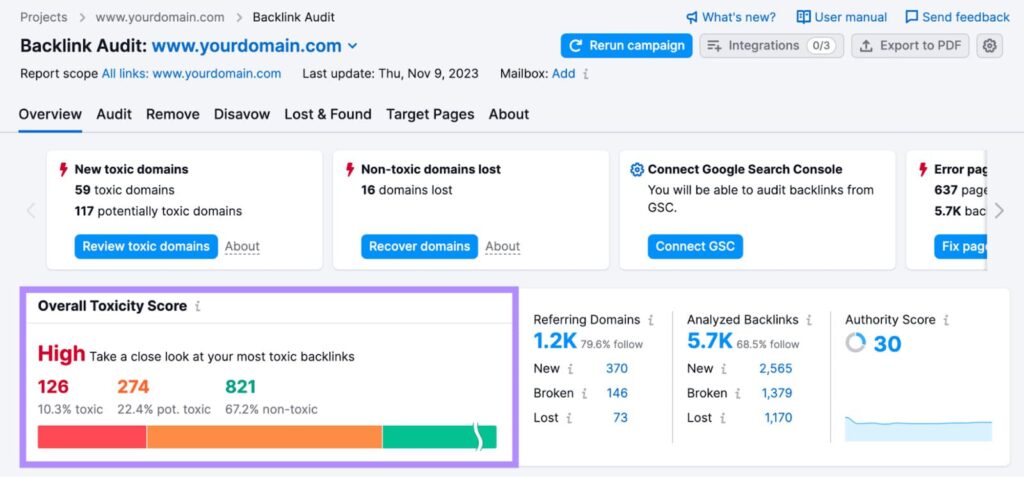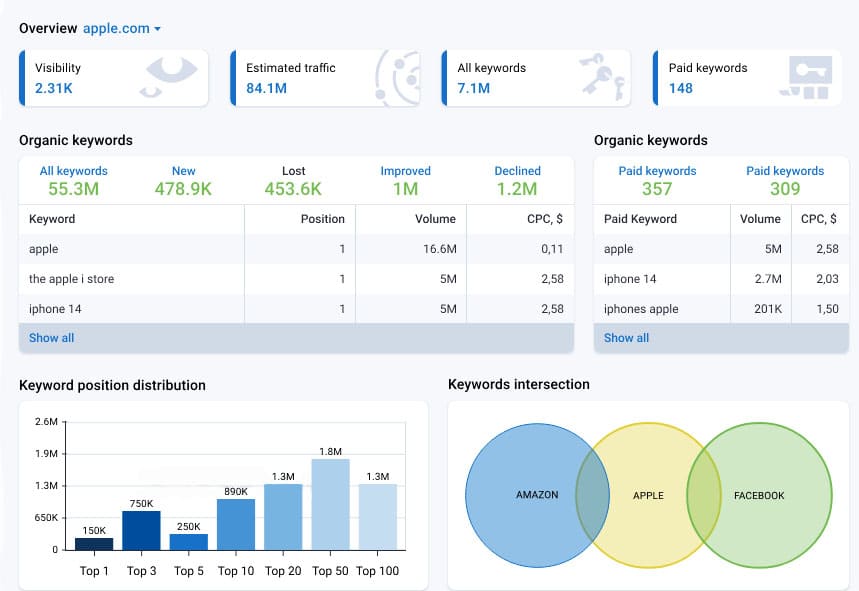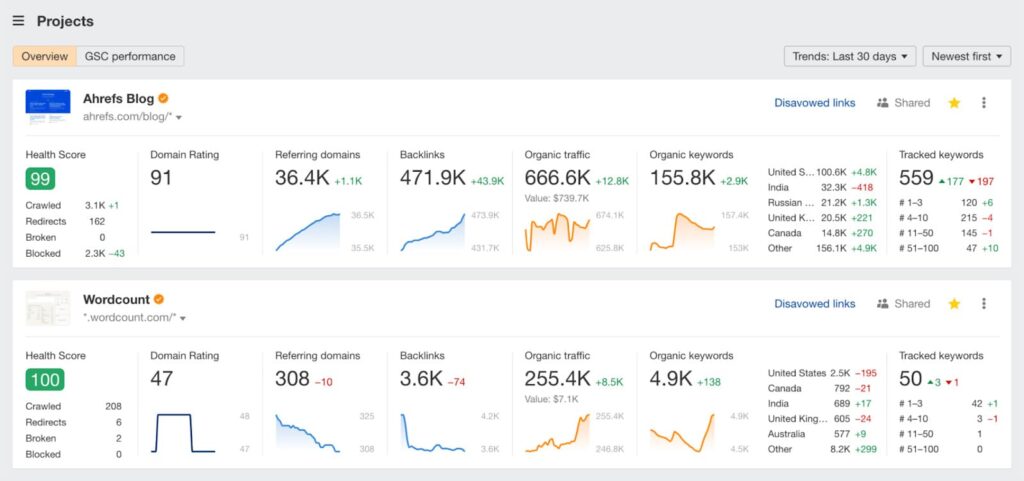How to Set SEO Goals & Objectives
To maximize the effectiveness of SEO promotion, it is essential to correctly define business goals and tasks that drive the work. Depending on the brand’s industry or the company’s niche, their websites differ and therefore require the application of different marketing strategies and specific actions. To optimize tasks, you need to determine the SEO goal first. Only after that can a business strive to reach the top leaders among competitors.
What is the goal of SEO?
The main task of professional search engine optimization is to increase the visibility of a business website in search results across various popular online platforms. After entering the target keyword, each internet visitor will only see what the search results display. However, the brand’s website may also be among the listed sites, though further down in the rating. Factors influencing the ranking and high visibility of a business website include not only the frequency of correctly selected and relevant key phrases but also the site’s position in search engines (as a result of other factors) and the click-through rate (CTR) of users.

Why Set SEO Goals?
It is important to establish brand objectives before starting a project to better understand search intent, increase conversion, reduce bounce indicators, and elevate the business website to a new, higher, and more stable level. Essentially, if a brand or company sets clear tasks, it can improve its ranking and reach the top positions in search engines. Well-defined SEO goals within a strategy will make the website more visible, recognizable, and widely accessible across the internet. This, in turn, will expand reach, increase user loyalty, attract a broader audience, bring in new customers, and ultimately maximize business revenue.
The Difference Between SEO Goals and SEO Objectives
An SEO objective refers to the overall result that a specific business wants to achieve in the future (e.g., raise organic traffic by 20% in 6 months). In other words, a brand sets a purpose that is strategic and long-term. On the other hand, an SEO goal refers to a specific step that can be measured to achieve the purpose (e.g., increasing free traffic by at least 20% within six months). In this case, the company sets a task that is tactical and short-term. It’s quite simple: in the first case, you ask, “What do we want?”, and in the second case, “How will we achieve it?”.

How to Set SMART SEO Goals
To establish a SMART SEO goal, a business needs to take several key steps. Specify and define clear ambitions and targets, such as raising organic traffic to the website. Ensure measurability by setting quantifiable indicators, such as reaching 10,000 subscribers or visitors per month. Ensure attainability by making business objectives realistic based on current resources and data. Ensure relevance by aligning intentions with overall brand objectives, such as improving lead acquisition or reducing bounce rate. Set a time frame, such as achieving the SEO goal within six months.
What Are SMART SEO Goals?
A SMART SEO goal consists of specific, measurable, achievable, relevant, and time-bound intentions that guide efforts in professional search engine optimization. They ensure that SEO strategies are well-directed and trackable. For example, increasing organic traffic by 35% within six months or improving a business website’s ranking in popular search engines for specific phrases by a set date. SMART intentions provide clarity and direction for achieving the first search engine results pages (SERPs) and other success metrics.

Specific – Defining clear SEO objectives
Setting precise, clearly defined purposes for search engine optimization efforts and promoting a business project on the Internet — whether improving the positions of a brand’s or company’s website or increasing traffic for specific phrases — is exactly what ensures focus and helps measure progress on the path to success.
Measurable – Tracking SEO work with performance metrics
It is important to establish measurable key performance indicators, such as organic traffic, bounce rate, or ranking for a specific keyword. These intentions, combined with the use of digital marketing tools as a whole, allow for tracking effectiveness and adjusting an individual strategy based on overall informational data.
Achievable – Setting realistic SEO goals
It is necessary to ensure that all SEO goals are fully achievable, considering the current resources allocated for promotion, the investments made in the business project, and the general market conditions at the moment. By setting challenging yet attainable purposes, such as increasing the conversion rate or improving the website’s search results, while avoiding overly ambitious targets and intentions that may lead to disappointment, it becomes possible to navigate the promotion process without difficulties.
Relevant – Aligning SEO with business goals
It is crucial to make sure that SEO goals align with broader business intentions, such as increasing the number of potential clients, enhancing brand awareness, strengthening the company’s reputation in the modern market, and more. This ensures that efforts in implementing professional digital marketing and optimization make a significant contribution to overall business growth and success.
Time-Bound – Establishing a timeline for SEO success
It is always necessary to set specific and clear deadlines for achieving purposes related to promotion, considering the implementation of digital marketing and other effective web technologies. For instance, 3 months, 6 months, or 1 year. A defined timeframe allows businesses to focus efforts on specific aspects and enables better tracking and evaluation of the progress of all undertaken SEO solutions.
Setting SMART SEO Goals for Different Business Objectives
Various theories can help in solving business tasks, but in practice, it is essential to set realistic and clear purposes that define the work stages, optimize all decisions, save time, and track SEO progress. The SMART method helps break down the plan into activities and determine the necessary resources to achieve intentions.
Increasing organic traffic
To set SMART SEO purposes for raising organic traffic, define a clear target, such as increasing website visits by 20% within six months. Measurable indicators, like unique visitors or page views, should be used to track progress. Ensure that the purpose is achievable based on the current website, aligns with business growth, and is set within a specific timeframe.

Optimizing conversion rates
SMART SEO purposes may include increasing the percentage of users through subscriptions or online purchases, boosting conversion, and more. For example, when a specific goal is set, it becomes easier to track, allowing for a clear understanding of the measurable results that need to be achieved (e.g., how much customer engagement should increase or how much overall business revenue should grow).
Reducing bounce rate
Clear SEO objectives for reducing the bounce rate can be set within specific timeframes. For example, within a certain number of months, it may be necessary to decrease bounce rate indicators by 15%. To achieve this, it is essential to improve page loading speed, optimize content, and ensure a user-friendly web design with clear timeline checkpoints.
Key SEO Goals to Consider
The keywords and intentions of SEO to consider include increase organic traffic, improving a business website’s position in search engines, optimizing conversion, and enhancing the user experience. By setting clear, measurable targets for each area, businesses can drive online growth, improve their search results, and ensure their brand or company website effectively meets the needs of Internet users. However, to improve a website in this way, significant effort is required.

Boost Traffic & Rankings
Increasing traffic and improving positions in search engines can only be achieved through effective strategies. It is crucial to update and modernize content, select relevant key phrases and keywords, and build high-quality links, as these efforts will grow visibility and attract the target audience.
Target Relevant Keyword
Choosing key keywords that match the target audience’s queries is a challenging but achievable task. It requires competitor analysis and the use of both low-frequency and high-frequency keywords to reach a wider audience and improve positions in search engines.
Optimize Content
Creating valuable, unique, and well-structured SEO content is essential for any powerful business project. To achieve this, it is necessary to use headings, lists, images, and internal links to boost readability and satisfy the requirements of search engine algorithms.
Build High-Quality Backlinks
Gaining authoritative backlinks is best done through reliable and verified web resources. Guest posts, collaborations with bloggers and influencers, and publishing on industry-related web sources will help strengthen a business’s SEO profile and grow trust with popular search online engines.

Improve Engagement
Boost user engagement by providing high-quality SEO content, intuitive navigation, and interactive elements to keep visitors on the business website longer. This will enhance audience interaction with the site, help increase customer acquisition, and improve positions on Google and other online platforms.
Reduce Bounce Rate
It is important to lower the bounce indicator by creating highly relevant content that meets user expectations. To achieve this, focus on growing the website structure, adding calls to action, and incorporating multimedia elements to capture the target audience’s attention.
Enhance Internal Links
When optimizing, internal links should be used to improve navigation and distribute link equity across web pages. This helps users find the necessary information and boosts SEO while growing the time spent on the business website.
Optimize for Mobile
Adapting a website for mobile devices is essential in today’s digital world. Optimization efforts, such as ensuring fast loading speeds, a user-friendly menu, and a responsive design, will help. Google prioritizes mobile-friendly websites, making optimization crucial for boosting positions.

Improve Page Speed
To speed up page loading times, it is essential to implement measures such as using optimized images. Additionally, caching and code minimization can also boost speed. A fast-loading website improves user experience, reduces bounce rates, and positively impacts SEO efforts.
Drive Conversions
Boost the number of customer acquisitions by creating a seamless user journey, growing content, and optimizing calls to action. It’s essential to analyze audience behavioral factors, test different strategies, and improve the website to boost customer acquisition and achieve key business intentions.
Align with Business Goals
Aligning your marketing strategy with business ambitions is the right approach. To do this, you need to define key performance indicators (KPIs), adapt content and marketing campaigns to attract more target audiences and boost sales or lead generation.
Implement Conversion Tracking
Using analytics systems like Google Analytics is essential for tracking user behavior and evaluating marketing campaign effectiveness. This helps identify weak points in the sales funnel and improve strategies on time.

A/B Test Landing Pages
Conducting A/B testing of landing pages is crucial to determining which elements — headlines, CTAs, images — perform best. Based on split-testing data, you can improve UX/UI and content, enhancing website ratings and user satisfaction.
Aligning SEO Goals with Business Objectives
An effective strategy that takes into account marketing technologies must align with business purposes to deliver maximum benefits. Companies like Amazon, HubSpot, and other well-known global brands use professional SEO to increase their reach and revenue growth. Therefore, for small and medium-sized businesses to achieve the same success as large corporations, it’s crucial to synchronize goals with the overall brand strategy and achieve sustainable success.

Identifying Core Business Goals
Before undertaking any optimization activities, it is important to define core business intentions. This specifically refers to increasing sales, attracting leads, or enhancing brand awareness. For example, Nike focuses on organic traffic to promote new collections, which is not surprising, as it’s their normal desire to become a leader in their niche and engage customers with something new. You can always work the same way they do, as long as you have a clear understanding of the purposes for building an effective individual and comprehensive strategy.
Selecting Key Performance Indicators (KPIs)
Choosing KPIs helps measure the success of all SEO campaigns. For example, Booking.com tracks organic traffic and ratings to assess the effectiveness of content, as their website is mainly used to find something, and content plays a crucial role for them. Therefore, for each business, it’s necessary to select the right metrics and create content that fits on a case-by-case basis to use them and adjust the promotion strategy.
Creating a Realistic Timeline for Goal Attainment
SEO is primarily a long-term strategy. For example, Forbes notes that achieving stable results may take 6-12 months, and that’s still quite a short period. Small businesses need to understand how to properly plan timelines, organize promotional work to achieve all initial purposes, and avoid unrealistic expectations, so they don’t become discouraged by not reaching a goal or success faster.
Implementing Tracking Mechanisms and Analytics Tools
Google Analytics and SEMrush help track the effectiveness of professional SEO. For example, Shopify uses these tools to analyze behavioral factors and improve content. To promote a small business, it’s essential to figure out which mechanisms will help the brand or company accurately measure results. Essentially, it’s important to select one of the automated services that will systematize data auditing tasks, save time and resources, and be comfortable to use for a business in a specific niche.

Preparing Comprehensive Reports
Comprehensive reports demonstrate the progress and effectiveness of an individual business strategy. For example, Moz regularly publishes reports on the state of search engine optimization, and tracking them allows you to understand the state of their affairs. Therefore, before launching promotion efforts, it’s important to know what specific data should be included in the report (such as clicks, website visits, unfinished transactions, or incoming audience, etc.) and how to use this data in the future to become a leader in the modern market.
FAQ
How can I ensure my SEO goals are realistic and achievable?
To make SEO intentions realistic and achievable, it is important to base them on data and analytics. The SMART method can be applied: the goal should be specific, measurable, achievable, relevant, and time-bound, and nothing else. It is also important to analyze competitors and take into account the current state of the website. Regularly tracking key indicators (traffic, ratings, positions) and adjusting the strategy based on these metrics is crucial. Working on improving content, technical optimization, and the backlink profile will always help achieve more stable growth.
What are some common examples of SEO goals?
Common SEO purposes include increasing organic traffic, improving positions for key phrases, improving positions, enhancing brand visibility, and reducing the bounce indicator rate. Companies and brands may aim to expand their semantic core, improve user experience, increase mobile traffic share, or strengthen local SEO. Goals related to building a quality backlink profile, speeding up page load times, and increasing indexing of new pages in Google and other popular online systems are also common.
How often should I review and adjust my SEO goals?
The review of SEO purposes should be conducted regularly, on average, once per quarter. However, depending on the dynamics of changes in online system algorithms and competition, the analysis may be monthly. Monitoring key indicators (positions, traffic, ratings) helps to respond to changes on time. If the strategy does not bring the expected results, it should be adjusted by testing new approaches: revising content, making technical improvements, changing the backlink strategy, or focusing on local SEO.
What Is the Goal of SEO for Businesses?
The main purposes of SEO for businesses are attracting targeted free traffic and improving the business website’s positions across many other indicators. Optimizing the brand or company website helps increase visibility in Google and other online systems, attract potential customers, and build trust in the brand. Professional SEO contributes to sales growth, improving user experience, and competitiveness. For local businesses, promoting in regional results search is important, while for e-commerce, improving the positions of product pages and increasing the number of orders is crucial.





